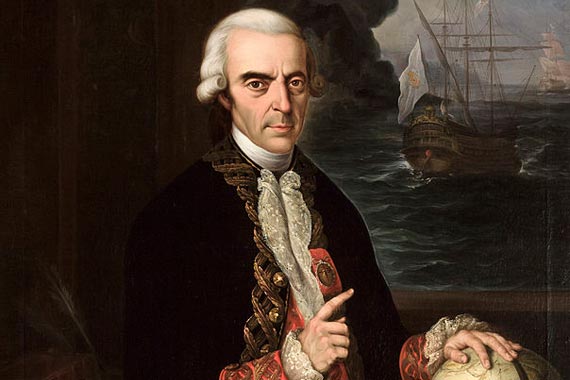We know it as the most expensive of precious metals, perhaps because platinum credit cards and platinum records surpass their gold equivalents in terms of prestige. The truth is that the market price of platinum is not necessarily always higher than that of gold, exceeding its abundance –in fact- in the earth’s crust. But its use in jewelry has made it a luxury material, despite the humble meaning of its original name: platina, or “little silver”.
Spanish explorer and serviceman Antonio de Ulloa —who some sources credit as the discoverer of platinum, as he was responsible for introducing it to Europeans— named it that way. On the other hand, other sources attribute this merit to the British scientists who brought it to Europe and studied their properties. The third centenary of Ulloa’s birth is a suitable occasion to commemorate his life and revisit the controversy surrounding the authorship of the discovery of the most exclusive precious metal.

Antonio de Ulloa y de la Torre-Giralt (12 January, 1716 – 5 July, 1795) was the second son of an influential and wealthy Sevillian family. His naval career led him to cross the Atlantic Ocean when he was very young: at the age of 19 he joined —in the company of Jorge Juan and Santacilia— the French Geodesic Mission set up to measure a meridian arc in equatorial America with the aim of determining the shape of the Earth. It was then that Ulloa became aware of a metal impurity found in American gold, which he called platina. As chemist and historian Luis Fermín Capitán Vallvey —professor at the University of Granada (Spain)— explained to OpenMind, “platina became known in the Viceroyalty of New Granada as an accompaniment of gold in the Chocó region [current Colombia] from 1690 onwards, which is how Ulloa himself was told of its existence when travelling through Popayan, as its Mint Office found it to be a recurring problem”.
Ulloa would return to Spain in 1745. Three years later he published Historical Relationaship with Jorge Juan, where he described platina -for the first time- as a mining rock” of such resistance, that it is not easy to break or cut with the force of blows on a steel anvil” and which “also resists calcination”. Some sources suggest that Ulloa took some samples of the metal to Spain. However, according to Leslie B. Hunt —co-author of the book A History of Platinum and Its Allied Metals (Johnson Matthey, 1982)— “there is no real evidence of this”.

Meanwhile, platinum was already the subject matter of studies being carried out in England. In 1741, the Briton Charles Wood found some metal samples in Jamaica,which had been smuggled from Cartagena de Indias. Wood conducted a number of experiments and sent the material to the physician William Brownrigg, who continued studying the new metal in Great Britain, later presenting his findings to William Watson, a member of the Royal Society. He in turn introduced platina to the British scientific establishment, as reflected in the journal Philosophical Transactions between 1749 and 1750.
It is worth stressing that Watson used the term ‘platina’ coined by Ulloa in his presentation to the Royal Society, writing: “This substance has not been mentioned by any author I know, with the exeption of our esteemed Antonio de Ulloa”. Later, in a letter, Brownrigg thanked Watson for adding this statement. In fact, Watson and Ulloa did meet: during his journey back from America, the Spaniard was arrested offshore by the British navy and jailed in London, where he was later released and recognized by the Royal Society, after it conducted a thorough examination of all his documents.
The American origin of platinum would initially give Spain a privileged position in its international trade. But in spite of that monopoly and the undeniable relevance of Ulloa in the history of platinum, giving the Spaniard the credit for its discovery would be an entirely different matter. The metal was already known by pre-Columbian cultures, and in fact this tenacious impurity had already been mentioned in Europe in 1557 in the writings of the Italian Julius Caesar Scaliger. Above all, some experts believe the paternity of an element must be attributed to the scientists who isolated and studied it. One notable example of this is tungsten, which is considered to be a Spanish contribution thanks to the work of the Elhúyar brothers, despite the fact that the element’s existence had already been suggested -and its name coined- by other authors.
In the case of platinum, Ulloa did not investigate its properties. According to Capitán Vallvey, the explorer “did not have at that time either chemistry knowledge or the means”. His role was to “introduce the existence of platinum in Europe”, hence there should be no confusion between “the dissemination of the existence of a new material and the discovery of a new metal”. The chemist and historian states that “the discovery of platina -as a new metal and later as a set of metals (the six platinum group elements)- must be attributed to Wood and Brownrigg”. However, he clarifies that “this does not in any way downplay the role of Ulloa. It simply avoids attributing to him what should not be”. In Capitán Vallvey’s view, Ulloa will long be remembered as “a model of enlightenment, although it was not he who discovered platinum”.
Comments on this publication